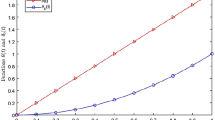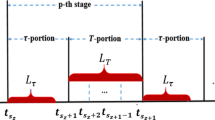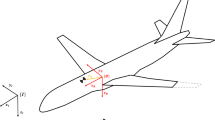Abstract
In this article, a new metaheuristic algorithm named average differential evolution with local search (ADE-LS) has been developed and implemented to find the optimal coefficients of unknown infinite impulse response (IIR) system as a system identifier. The developed method minimizes the error between unknown system output and the adaptive IIR filter output. Rapid convergence is aimed for the global solution in system identification problem using the ADE-LS based adaptive IIR filter modelling with local search. In this way, more precise prediction of filter coefficients is ensured in the filter design with multimodal error surface. ADE-LS algorithm is applied to four benchmarked IIR systems commonly studies in literature to show its performance. Results found by using ADE-LS are compared to other methods reported in terms of convergence rate and the mean square error value. The attained results approve the efficiency of the suggested method.











Similar content being viewed by others
References
Mitra SK (2011) Digital signal processing: a computer-based approach. McGraw-Hill, New York
Diniz PSR (2008) Adaptive filtering algorithms and practical implementation. Springer, New York
Sayed AH (2003) Fundamentals of adaptive filtering. Wiley, New York
Soltanpour MR, Khooban MH (2013) A particle swarm optimization approach for fuzzy sliding mode control for tracking the robot manipulator. Nonlinear Dyn 74:467–478. https://doi.org/10.1007/s11071-013-0983-8
Ma Q, Cowan CFN (1996) Genetic algorithms applied to the adaptation of IIR filters. Signal Process 48(2):155–163. https://doi.org/10.1016/0165-1684(95)00131-X
Dai C, Chen W, Zhu Y (2010) Seeker optimization algorithm for digital IIR filter design. IEEE Trans Ind Electron 57(5):1710–1718. https://doi.org/10.1109/TIE.2009.2031194
Radenkovic M, Bose T (2001) Adaptive IIR filtering of nonstationary signals. Signal Process 81(1):183–195. https://doi.org/10.1016/S0165-1684(00)00196-1
Shengkui Z, Zhihong M, Suiyang K (2007) A fast variable step size LMS algorithm with system identification. In: Proceedings of 2nd IEEE conference on industrial electronics and applications, Harbin, China, pp 2340–2345
Guan X, Chen X, Wu G (2009) QX-LMS adaptive FIR filters for system identification. In: Proceedings of 2nd IEEE international congress on image and signal processing, Tianjin, China, pp 1–5
Kaya Y, Kayci L, Tekin R, Ertuğrul ÖF (2014) Evaluation of texture features for automatic detecting butterfly species using extreme learning machine. J Exp Theor Artif Intell 26(2):267–281. https://doi.org/10.1080/0952813X.2013.861875
Purcaru C, Precup RE, Iercan DT, Fedorovici LO, David RC, Dragan F (2013) Optimal robot path planning using gravitational search algorithm. Int J Artif Intell 10(13):1–20
Panda G, Pradhan PM, Majhi B (2011) IIR system identification using cat swarm optimization. Expert Syst Appl 38:12671–12683. https://doi.org/10.1016/j.eswa.2011.04.054
Saha SK, Kar R, Mandal D, Ghoshal SP (2014) Harmony search algorithm for infinite impulse response system identification. Comput Electr Eng 40:1265–1285. https://doi.org/10.1016/j.compeleceng.2013.12.016
Upadhyay P, Kar R, Mandal D, Ghoshal SP (2014) Craziness based particle swarm optimization algorithm for IIR system identification problem. AEU Int J Electron Commun 68(5):369–378. https://doi.org/10.1016/j.aeue.2013.10.003
Kumar M, Aggarwal A, Rawat TK (2016) Bat algorithm: application to adaptive infinite impulse response system identification. Arab J Sci Eng 41:3587–3604. https://doi.org/10.1007/s13369-016-2222-3
Upadhyay P, Kar R, Mandal D, Ghoshal SP, Mukherjee V (2014) A novel design method for optimal IIR system identification using opposition based harmony search algorithm. J Frankl Inst 351(5):2454–2488. https://doi.org/10.1016/j.franklin.2014.01.001
Zou DX, Deb S, Wang GG (2018) Solving IIR system identification by a variant of particle swarm optimization. Neural Comput Appl 30:685–698. https://doi.org/10.1007/s00521-016-2338-0
Jiang S, Wang Y, Ji Z (2015) A new design method for adaptive IIR system identification using hybrid particle swarm optimization and gravitational search algorithm. Nonlinear Dyn 79(4):2553–2576. https://doi.org/10.1007/s11071-014-1832-0
Singh S, Ashok A, Kumar M, Rawat TK (2019) Adaptive infinite impulse response system identification using teacher learner based optimization algorithm. Appl Intell 49:1785–1802. https://doi.org/10.1007/s10489-018-1354-4
Saha SK, Kar R, Mandal D, Ghoshal SP (2013) A new design method using opposition based BAT algorithm for IIR system identification problem. Int J Bio-Inspired Comput 5(2):99–132. https://doi.org/10.1504/IJBIC.2013.053508
Durmuş B (2018) Optimal components selection for active filter design with average differential evolution algorithm. AEU Int J Electron Commun 94:293–302. https://doi.org/10.1016/j.aeue.2018.07.021
Civicioğlu P (2013) Backtracking search optimization algorithm for numerical optimization problems. Appl Math Comput 219(15):8121–8144. https://doi.org/10.1016/j.amc.2013.02.017
Tseng LY, Chen C (2008) Multiple trajectory search for large scale global optimization. In: Proceedings of 2008 IEEE congress on evolutionary computation, Hong Kong, pp 3052–3059
Storn R, Price K (1997) Differential evolution—a simple and efficient heuristic for global optimization over continuous spaces. J Glob Optim 11:341–359. https://doi.org/10.1023/A:1008202821328
He Q, Wang L (2007) An effective co-evolutionary particle swarm optimization for constrained engineering design problems. Eng Appl Artif Intell 20:89–99. https://doi.org/10.1016/j.engappai.2006.03.003
Funding
No funding was received.
Author information
Authors and Affiliations
Corresponding author
Ethics declarations
Conflict of interest
The author declares that he has no conflict of interest.
Additional information
Publisher's Note
Springer Nature remains neutral with regard to jurisdictional claims in published maps and institutional affiliations.
Rights and permissions
About this article
Cite this article
Durmuş, B. Infinite impulse response system identification using average differential evolution algorithm with local search. Neural Comput & Applic 34, 375–390 (2022). https://doi.org/10.1007/s00521-021-06399-4
Received:
Accepted:
Published:
Issue Date:
DOI: https://doi.org/10.1007/s00521-021-06399-4




